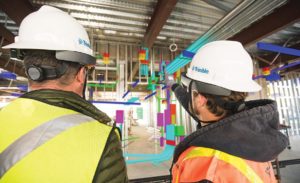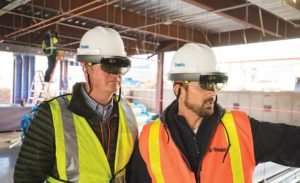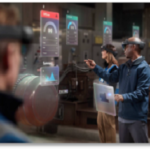Mixed Reality Boosts BIM in Construction
Building information modeling (BIM) is no longer a future state, but something geospatial professionals and contractors are putting to use today on building and infrastructure projects. Whether it’s visualising a design, allowing stakeholders to ‘walk through’ a building before it’s complete, or using models to validate work being done according to the design, BIM has arrived.
Another exciting development around BIM is mixed reality (MR) technologies. Mixed reality is a form of augmented reality (AR) that merges real and virtual worlds to create brand new environments where physical and digital components interact in real-time. In architecture, engineering and construction (AEC) industries, MR is bringing new levels of simplicity to BIM, making it a useful tool in commercial applications. In fact, manufacturing and construction spending on AR and virtual reality (VR) solutions is poised to overtake the consumer sector in the next five years, according to International Data Corporation (IDC) research.
An Eye on Collaboration
Mixed reality solutions are being simplified through new data platforms that reduce the time needed to place models in the physical space, as well as robust wearable technology that can store and load data to speed review of modeled data on the worksite. More than just viewing data, today’s MR applications allow users to also interact with what they see on a 1:1 scale and compare components against design and installation guidance. For instance, Microsoft HoloLens, a holographic computer and head-mounted display, attaches to hard hats and enables users to use natural gestures, such as clicking with fingers, pinching the screen or moving objects on the screen, to interact with data.
Bringing the utility of mixed reality onto the construction site even further is Trimble Connect for HoloLens (TCH). Trimble Connect for HoloLens enables users to view models that have been published to their HoloLens device via the Trimble Connect software application. The application links to project models stored on Trimble Connect, a cloud-based construction management solution that acts as a collaboration hub for AEC projects. By using it, contractors can work with BIM models and read files from several different sources, including from those tools used by other trades. Adding to collaboration efforts, with just a few clicks, a user can identify how the physical planes of the worksite relate to digital models.
Envision a superintendent on-site viewing the mixed reality data showing all the components and connections, down to the nuts, bolts and hangers ‘behind the walls’ directly in front of him. He discovers a clash between an existing wall penetration and the electrical plan. This triggers a request for information (RFI). He then contacts the virtual design and construction manager back in the office, who, by using the same technology, “transports” himself to the worksite to see what the superintendent sees.
To facilitate this seamless workflow, the team had loaded the structural, architectural, electrical and mechanical models onto an ANSI-approved hard hat attachment for Microsoft HoloLens. The models, prepared by the design teams for each trade, were placed in the Trimble Connect dashboard. Wearing the HoloLens, stakeholders from the various trades were able to see the models overlaid on the physical space with surface-to-surface alignment. While this is a construction-specific, not survey-specific workflow, surveyors and geospatial professionals should be particularly invested in mixed reality’s success. Because surveyors establish boundaries and control for building projects, mixed reality can be a natural extension into new areas of service.
Practical Use of Mixed Reality
This scenario happened recently at the construction site of Trimble’s 118,000-square-foot, Phase 2 building in Westminster, Colorado just northwest of Denver. General contractor JE Dunn, architect OZ Architecture, and several trade partners in mechanical, electrical, plumbing, (MEP) layout and concrete are involved in the project. A major goal of the construction process was to validate the application of technology to foster collaboration, automate field activities, and enhance both predictability and safety.
Mixed reality solutions including Microsoft HoloLens, SketchUp Viewer for HoloLens, Trimble Connect for HoloLens, and Trimble’s new hard hat attachment for HoloLens were tested early on during the Trimble project primarily for concept visualisation, visual clash detection and as-built validation. Using the mixed reality solutions, Trimble, JE Dunn and other trade partners were able to view future work in the context of the current-built environment.
Mapping the Environment to Place the Model
While wearing the HoloLens on-site, the user logs into the Trimble Connect for HoloLens application to access the Trimble Connect dashboard and then selects the model layers he or she wants to view on site and loads them into the HoloLens. The Trimble Connect for HoloLens application then starts to “map” its environment in order to place the model. Common planes in the real world and the selected model are identified and verified by the user. Once selected, these planes enable TCH to automatically align the model to the physical environment. Once placed, the user can begin to take measurements or annotate. Measurements can include real-world-to-real-world, virtual-element-to-real-world, or virtual-element-to-virtual-element.
By bringing simplicity, practicality and real-time problem-solving capabilities to the worksite, mixed reality solutions are transforming the utility of BIM.
In the case of the Trimble Phase 2 project, the team did discover a clash in the ductwork between the hologram state and the existing steel. From there, they initiated a remote collaboration meeting, inviting the steel contractor to view both the scene and the models without leaving the office. This resulted in an immediate work order to correct the issue.
By bringing simplicity, practicality and real-time problem-solving capabilities to the worksite, mixed reality solutions are transforming the utility of BIM. The building construction industry is filled with opportunities for improved efficiency and productivity through BIM, which also is expanding into civil infrastructure, utilities, power stations and industrial facilities. With close collaboration among project stakeholders as one of the key benefits of BIM, cloud-based services and new mixed reality and software tools for visualisation will continue to increase BIM’s efficiency and effectiveness over time





